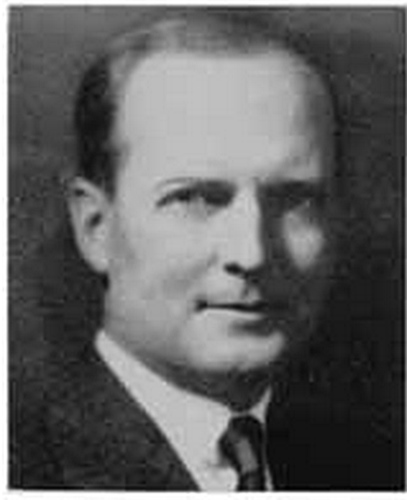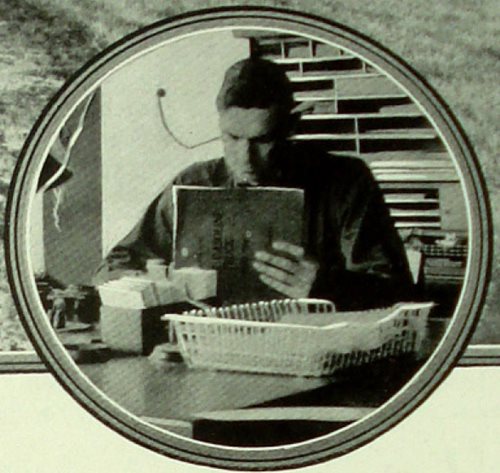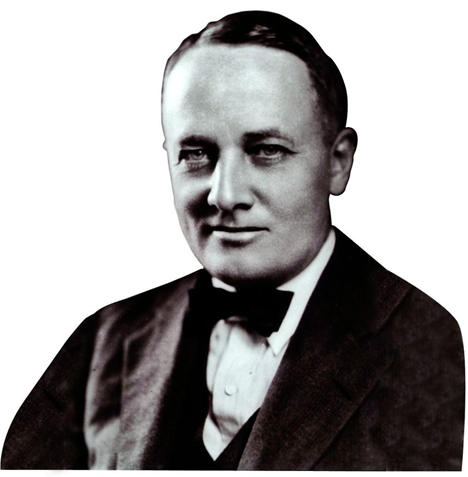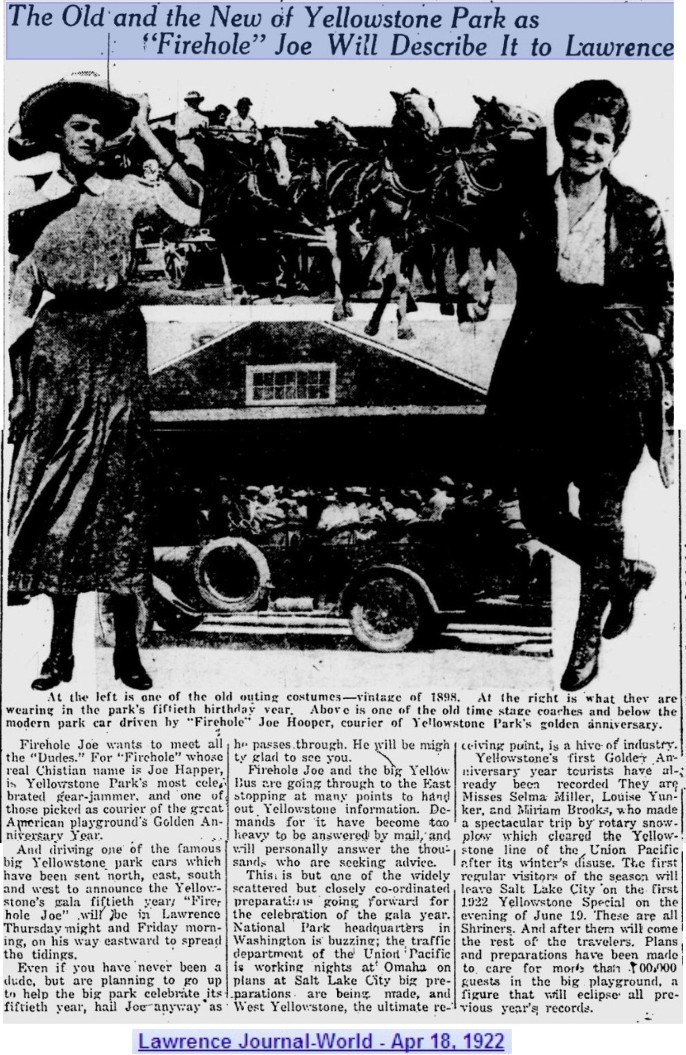|
|  | | Geyser Bob's Yellowstone Park History Service | | Serving the Greater Yellowstone & Surrounding Gateway & Historic Communities |
|
|
|
|
|
| | | |
|
Harry W. Child
Child was born in San Francisco in 1857 and arrived in Montana in 1876. He was considered the “Father” of the lodging and transportation operations in Yellowstone until his death in 1931. Child was a businessman in Helena prior to his arrival in Yellowstone, working in the mining, banking and transportation fields. By 1882 he was managing the Gloster and Gregory silver mines, with his father apparently bankrolling the operations. He married Adelaide Dean in 1883. He formed the Helena, Hot Springs and Smelter Railroad Co. in 1889 with Edward Bach and two other men. The business was forced into receivership and sold at public auction in 1891. For a time he was also an agent for the Gilmer & Salisbury Stage lines. He began his Yellowstone career in 1892 with the creation of the YNPTCo with brother-in-laws Edward Bach and Silas Huntley, along with Aaron and L.H. Hershfield. In 1898 Child, Huntley, and Bach formed the YPTCo that took over the operations of the YNPTCo. All of the transportation operations in the park were consolidated into YPTCo under Child’s control after the 1916 season. Child got involved in the hotel business in 1901 when he, along with Bach and Huntley, purchased the YPA. By 1905 Child owned 50% of YPA and the NPRY owned the other half. He formed the Yellowstone Park Hotel Co. in 1909, and bought out the camping/lodge operations in 1928. Child purchased a large interest in the Wylie Permanent Camping Co. in 1905, but was forced to give up his holdings with the consolidations of 1916-17. He took over the Tom Hofer Boat Co. in 1911 and created the Yellowstone Park Boat Co. He ran all of these businesses until his death in 1931 at La Jolla, Calif., at age 75. Son-in-law Wm. Nichols then took over and all of the operations, which were merged together to form the Yellowstone Park Co. in 1936. The family continued to own the operation until 1966 when the company and assets were sold to Goldfield Enterprises.
|
 |
Nichols, William Morse
William Nichols, familiarly known as "Billie," was born in 1881 in Hartford, Conn. He attended the US Military Academy at West Point from around 1899 to 1903. He graduated as a second lieutenant in 1903 and was assigned to the 11th Cavalry and sent to Yellowstone Park. He married Harry Child’s daughter, Ellen Dean Child, in 1905 and resigned his commission in the Army in September of that year. In 1907 he served as secretary to Harry Child, and two years later became Secretary of the newly formed Yellowstone Park Hotel Co. He was the second largest shareholder of the Cody-Sylvan Pass Motor Co. in 1916 with 28% of the shares. With the death of Harry Child in 1931, Nichols was elevated to president of the company. The various Child/Nichols enterprises were merged together in 1936 with Nichols as President of the new Yellowstone Park Co. During the lean war years, business was bad in the park and few facilities were open. Nichols was forced to sell his shares of the Flying D Ranch in 1944 to help pay off debts to the railroad companies. During the mid-1940’s his son John Q. gradually began to take over active management of the company. In 1956 Billie resigned as president of the company to take over as chairman of the board of directors of YPCo. He remained with the company until his death on August 6, 1957 at Mammoth, after suffering a heart attack about nine days earlier.
|
 |
Fred E. Kammermeyer
F.E. Kammermeyer was Transportation Superintendent for H.W. Child and the Yellowstone Park Transportation Co. from 1917 to the 1940’s. He had been a military transport officer during WWI and was hired by Child to set up and organize the operation of the new fleet of 117 White buses in 1917. These buses replaced the stagecoaches that had been used up until that year. Kammermeyer was born June 30, 1888 in Burlington, Iowa to parents Fred Christian Kammermeyer and Lidia Wilhelmina Tillman. Sometime after 1920 Fred married Evelyn Johnson, who was born in 1888 in Ohio. In the fall of 1924 Fred was an Engineering Extension Student with the University of Wisconsin. In a letter to the college Extension Division, Fred commented upon his employment in Yellowstone that summer: “We handled nearly 150,000 tourists this season, and I supervise six garages and 322 busses and trucks with all the grief that goes with it; so you can readily understand that I could not give study any concentrated thought – much less time – as I put in about 18 hours a day trying to keep up with the problems.” He retired Sept. 30, 1948 as Manager of Transportation Div. Yellowstone Park Co. The Polk Guides list Fred’s residence as Livingston, Montana in 1943, Billings in 1944, and Bozeman in 1950. According to the Allday family website, Fred died of a gunshot wound to the head on December 21, 1967 at Sun City, Arizona. He was buried in the Sunland Cemetery. Evelyn died March 20, 1969 in Glendale, Arizona.
(Geyser Bob website, Personalities Pages)
|
 |
Walter C. White
Walter White headed the White Motor Company that manufactured automobiles and trucks, although they originally started out in the sewing machine business. The White Company provided 117 touring buses to YPTCo for the 1917 season to replace the stagecoaches. That first season there were 100 10-passenger ¾-ton TEB buses and 17 7-passenger buses. A fire at the YPTCo garage at Mammoth in March of 1925 destroyed about 92 White buses. The White Company rushed to produce 90 new White Model 15/45 10-passenger buses in time for the park opening in June. In 1931 eight 14-passenger buses (614 series) were tried out, and in 1936-39 YPTCo bought 98 14-passenger buses of a different design (Model 706). The autos all featured open tops for unobstructed viewing by the passengers. White Co. provided touring cars to many of the other western national parks during that period of time. In 1914 White teamed up with Roe Emery to operate the Glacier Park Transportation Co., with the White Co. providing $60,000 worth of vehicles for the park that season. Two years later White and Emery setup a similar arrange at Rocky Mountain National Park. Walter White was a silent partner in the 1919 purchase of YP Camping Co. with Howard Hayes and Roe Emery. Ironically, White died in an automobile crash in October of 1929, while driving a Stutz.
(Geyser Bob website, Personalities Pages)
White was once quoted " If you want a man to have faith in you”, said Walter “you must not betray his trust. When a man gets a good White truck it is not by accident. They are built neither by guess nor by luck, but by mathematics, science, and a system of testing which has no superior in the automobile field. When a White truck leaves the plant it carries with it the honor of the Whites.”
Time Magazine, Oct. 7, 1929
Died. Walter C. White, 53, Coca-Cola director, longtime motor maker, who last year sold some $47,000,000 worth of White trucks and buses; of an internal hemorrhage, after an automobile accident; at Cleveland. Driving to work in a Stutz, he carromed into another car, hurtled into a vacant lot, fractured his right hip and leg. Out of the relics of his father's White Sewing Machine Co. grew White Motor Co., first manufacturing steam cars. Since 1921 he had been the company's president. During the War he was one of a committee to supervise U. S. Army motor transport, was made Chevalier de la Legion D'Honneur.
Link to Wikipedia webpage on White Motor Co.
Link to Coachbuilt.com webpage on White Motor Co. |
 |
|
Firehole Joe Hopper
A YPTCo bus gear jammer who in 1922 traversed the country on a goodwill mission advertising the 50th anniversary of the founding of Yellowstone Park in 1872. He once explained how he got his name in a Columbia Missouri newspaper in 1922:
Firehole Joe Spins a Yarn
“Firehole” Joe Hopper, Yellowstone Park bus driver, who was in Columbia yesterday, was explaining the origin of his name: “You see, it was like this. One year the Firehole River froze over and some of us went skating on it. Unfortunately the ice wasn’t as thick as it looked and I fell through. By the time they got me out I was almost scalded to death in the water under the ice.”
He was obviously carrying on a long-held tradition in the park of drivers, particularly the old stagecoach drivers (Geyser Bob was a classic example) who loved to spin yarns for the gullible dudes. This tale-spinning derived from the early trappers who exaggerated their experience a bit around the campfire or over a glass of grog back in civilization. Early 1800s trapper Jim Bridger was once quoted as saying, "Out thar in Yellowstone, thar's a river that flows so fast it gets hot on the bottom." He was referring to the Firehole River and indeed the bottom of river is indeed hot in places, but of course it is due to the thermal upwelling.
The newspaper article to the left is from the Lawrence (Kansas) Journal World, April 18, 1922.
|
 |
|
|
|
|
|
| |
|
| |